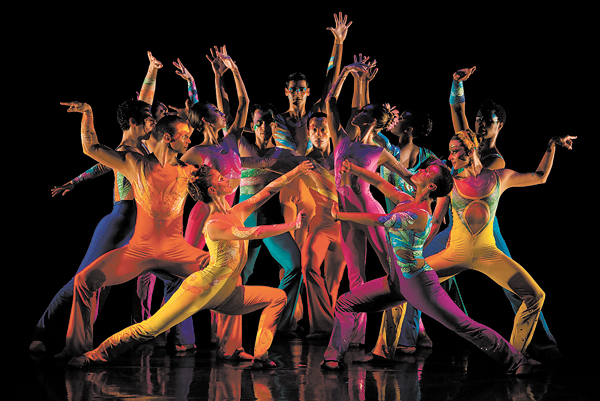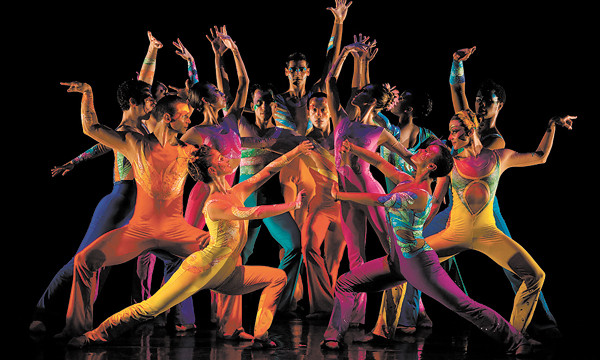By Montague Gammon III
Ballet Hispanico’s visit to the Virginia Arts Festival swirls (and leaps, struts, slides and lifts) through a Latino flavored look at matters as tangible as a kiss or as surreal as a Magritte painting.
The sweet and spicy Salsa vocals of the late Celia Cruz, the Havana born, New York based singer who was vilified by the Castro regime, and whose musical career spanned styles from Afro-Cuban to David Byrne to hip hop, are the heart of “Asuka.” That’s the first of four dances the company brings to the stage of the TCC Roper Performing Arts Center April 10.
The title is a variant of Cruz’s trademark frequent expostulation of “Azucar!” -– that is, “Sugar!” – during her own performances. That title also links the literally colorful work to the many ways in which sugar is important to Cuban society and to its economy, said the company’s Artistic Director, Eduardo Vilaro, and it reflects the “sweetness and savory soul of Cuban culture.”
Vilaro choreographed “Asuca” “In collaboration with the Company Artists,” and co-designed the brightly hued costumes with Diana Ruettiger.
Like Cruz, Vilaro is Cuban born; he says that “her extraction [from Cuba], like mine, was an impetus for our art forms.”
The story of leaving one’s homeland is “every Cuban-[American’s] story, or it was.”
Cruz became a world-touring celebrity before the advent of Castro. She and her band were in Mexico when he came to power; they decamped to the US rather than go back to Cuba. She became a US citizen in 1961, and went on a career that lasted some 40 years, earning herself Grammys, gold records, movie roles, a Miami street named after her, a Smithsonian Lifetime Achievement award, honorary Doctorates from Yale and the University of Miami, and the National Medal for the Arts.
“She went through this amazing journey in her music and she was such a mover and shaker for the Latins coming to the United States … she brought all of us together,” Vilaro said. “She was one of the performers who really connected me to my culture and made me say ‘I’m Cuban!’ ”
But Fidel Castro’s regime called Cruz a “worm that left the country,” and when her mother died Cruz was not allowed to come back for the funeral. All that made Ballet Hispanico’s performance of “Asuca” in Cuba last November especially meaningful, Vilaro said.
“It was the first time that her music was put on, blatantly, in a dance performance” in her native country since her exile, he continued. “They just exploded with joy,” and audience members told him afterwards, “You brought Celia Cruz back home.”
From the relatively accessible, multi-dancer “Asuca,” Ballet Hispanico moves to a “very abstract” duet, titled “Sortijas.”
The word means rings. “It’s a very old – ancient – word used for wedding rings, or to mean cycles,” Vilaro explained.
The music for “Sortijas” is provided by “a Mexican artist who sings in English about how a blind person loves. It’s very much about relationships, about being lost and trying to find oneself,” he said.
Of course, relationships and the history of any individual’s relationships often have cyclical natures. And by extension, that sense of “being lost and trying to find oneself” can apply to expatriates everywhere, and in this context, particularly to the people who make up what Vilaro termed the “Spanish diaspora.”
Third on the program is the “super athletic and super high energy and really mysteriously fun” all male “Sombrerísimo” – for which Vilaro promised noteworthy “lighting [and] sound effects.” It’s “about machismo and showing off … darkly humorous … speaking about the human condition that we live in and that we must laugh at.”
What “Sombrerísimo” is not about is the stereotypical Mexican/Latino sombrero.
The hats are bowlers (or, it seems in one clip of rehearsals, fedoras), derived from the Belgian surrealist painter René Magritte, whose subjects often sported such toppers. Vilaro says those lighting and sound effects bring the surreal world into the real one.
That same rehearsal clip interestingly shows what look like a few brief pas de deux between two men, each alternately taking the role traditionally assigned to a woman. There’s nothing gay or sexualized about the pairing, but the unconventional approach perhaps suggests something about the absolute self-assurance and disregard for superficial gender assumptions of the truly secure machismo man.
Plus it’s really cool to see a guy lifting another guy!
The concert – perhaps like some of the relationships in “Sortijas” – concludes with a kiss. Or lots of them.
“El Beso” – which means “The Kiss;” no surprise there – looks at all sorts of bussing. “The familial kiss, the passionate kiss, the friendly kiss, you will see all those,” said Vilaro. “It’s a very fun, totally joyous dance about this thing that is universal.”
The music is excerpted from zarzuelas, which Vilaro characterizes as Spanish operettas, though there is a strong Cuban zarzuela tradition as well.
Like most Arts Festival performers, Ballet Hispanico will be involved in educational programs during their time here.
“That’s exciting for us. We love doing that; it’s central to our mission,” which is, Vilaro concluded, “to give voice to all this artistry, so people can see the full depth … the experience, of what it is to be Latin.”
Ballet Hispanico
Friday, April 10, 8:00 PM
TCC Roper Performing Arts Center,
340 Granby Street, Norfolk
Virginia Arts Festival
757-282-2822





